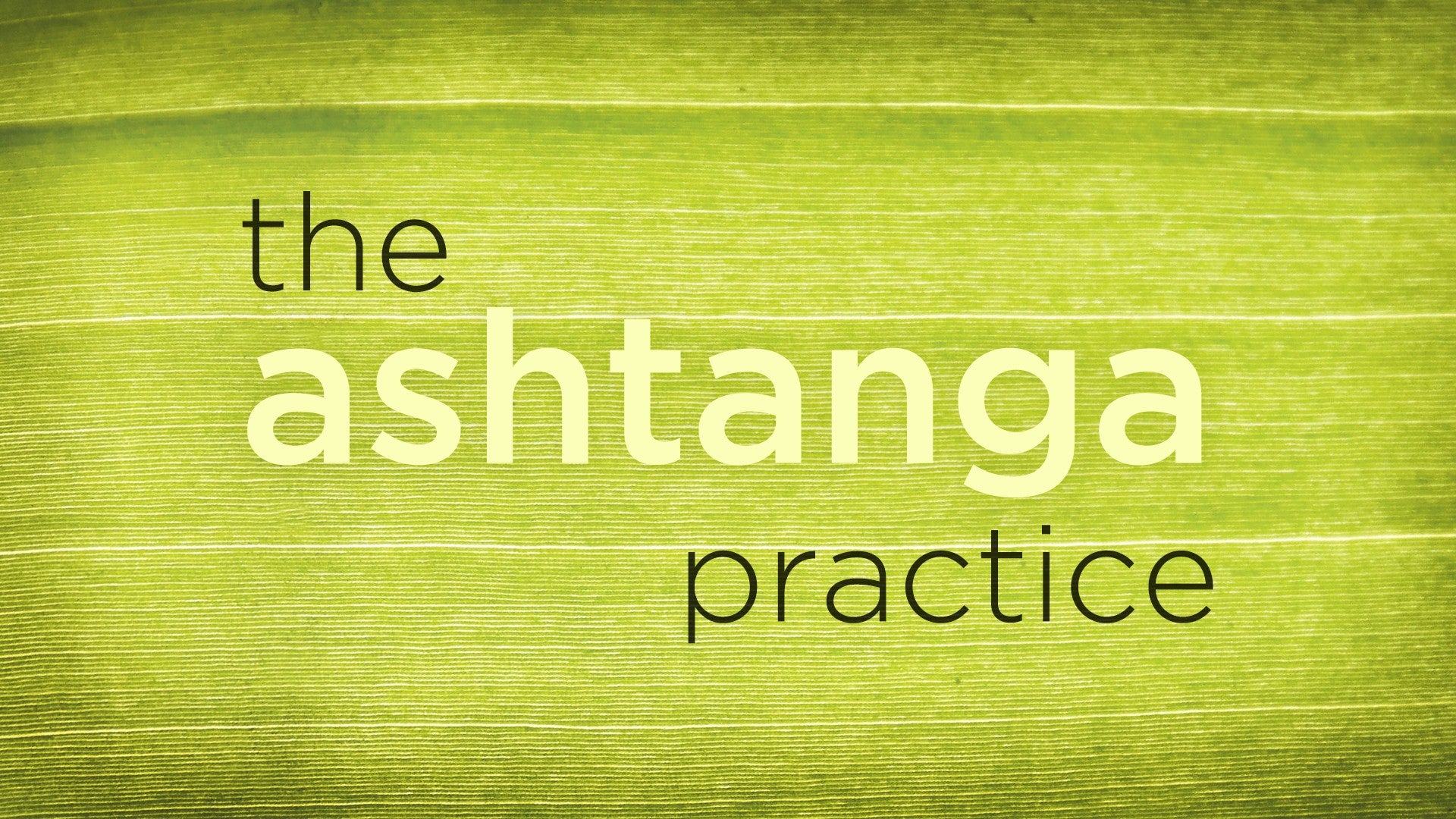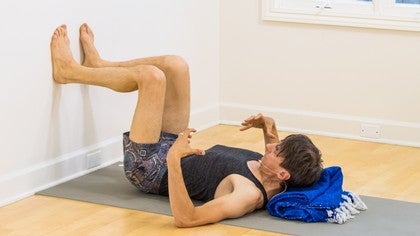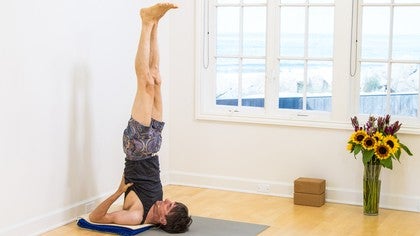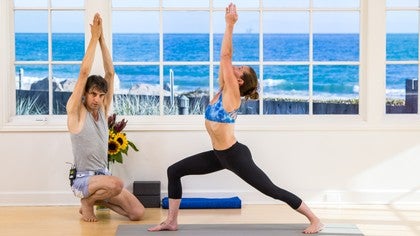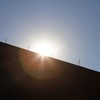Description
About This Video
Transcript
Read Full Transcript
(waves splashing) Greetings. So, we're gonna spend a little bit of time focusing on the breath. And, it is the heart of the practice, is working with breath. And I'm, call this breath power. So you're prana, life force.
So the name is pranayama. That means a setting free of the life force, of the prana that is yours. Okay? And so, you do that by focusing on your breath. And it's a long study, so part of it, really, kind of the essence of it is to remember your breath.
Really like, that's it. If you can remember your breath, then you can start to get breathing power, and get some measure of participation and control. And so every technique, every breathing technique is kinda like that, it just reminds you, and then it shows you how to... Once your reminded then what shall I explore? And a lot of what you're exploring is simply skillful breathing, how to use the lungs and the breathing musculature well.
And yeah, they have a, there is a statistic and it's questionable how accurate it is, but it's, it's telling. Says we normally use about one sixth the capacity of our lungs. One sixth! So that's five sixth dormant that never really gets explored because we, we walk around not really breathing. Okay? And so, that yoga is an entrance into exploring the full capacity of the breath.
Okay, so we're gonna do a little, couple of exercises, but one is, remember, we're talking about ujjayi as the main technique, okay? That's sound breathing. So ujjayi means victorious and expansive. So that's partly you're using a resistance in the throat to explore the capacity of the lungs, to create a magnificent expansion while you inhale, and a magnificent contraction while you exhale. So remember that ujjayi is closing the space between the vocal folds and making a sound like like this.
(deep breathing) Okay? So, when you do that, or to do that, to make that sound, you can do it with me. I want you to swallow very slowly. So get your slowest swallow. Okay, in the middle of that swallow, the glottis is closed.
No air can get through there. Okay? So ujjayi, you're making it very narrow, or you're actually, and you're extending your ability to control how much opening is there. So that takes practice. And one of the ways you practice it is with your moving with breath in your position.
Okay? So when you (deep inhale) breathe in and reach the arms up... (slow exhale) In fact, we'll do that, right here. Get a nice seat, and we'll just try it out. So breathe the arms up...
(deep inhale) And listen to the sound to create the movement. (slow exhale) And back and forth, and make the speed of the breath and the speed of the movement the same. (deep inhale) (slow exhale) (deep inhale) So I come to the peak as I finish my inhalation, and... (slow exhale) Descend the arms with the exhalation. Again.
(deep inhale) You're exploring that expansion of the chest with the inhalation, and... (slow exhale) the contractile force of the exhalation. Alright, so I'm gonna show you one of my favorite spot, positions to explore the breathing, and you use a blanket for your head. So it could be variable heights. I'm folding this blanket in half, and then in half again, okay?
And then, I lay down with my, kind of near the wall, and get my feet up the wall hip width apart, feet are parallel, and the shin is parallel to the floor, the knee is vertical over the hip, so that means the thigh is perpendicular to the floor, so I have a nice symmetrical leg shape. The whole spine is down, and then I place this support under my head. Okay? So, there's two points of focus that I want you to pay attention to here while we're working on this. One is you place your finger tips midway between the navel and the pubic bone, and you just let them rest there.
So that in there, that's your center. So you kind of, your fingers are there to sort of, like, almost like eyes or senses that are sensing that area. And the second area is right here, the very, the heart center. The top of the chest. So when you exhale, you breathe down to a point below where your fingers are, and when you breathe in, you breath in to a point where the heart center is.
So we'll play around with it a little bit. The chin is slightly down and you're working with ujjayi, so here we go, breath in, fill up the lungs to a nice capacity patiently, and then exhale. (slow exhale) The breath descends down and down, all the way into your belly. So you imagine that, and the belly falls. Breathe in (deep inhale) and try it again.
We'll focus on the out breath. So you're emptying the lungs with that sound, and there's a contraction that happens. (slow exhale) And breathe in again. So that contraction, the lungs contract, the muscles between the ribs contract, the belly contracts, and you're gonna flush the lungs in a downward move. And so, when you finish emptying your lungs, you're at a point below your finger tips in the lower belly.
Let's try again, breathe in (deep inhale) and then exhale with sound, smooth and steady. (slow exhale) Try to find a point down in the lower pelvis, and watch the belly fall. Again, breathe in... (deep inhale) And then empty your lungs with a contractile force to the point. It's called bindu, or drop.
Way down in the pelvis (slow exhale) watch the belly fall as you breath out. Again, last one. Inhale (deep inhale) and then exhale. (slow exhale) Okay? So just keep breathing, I'm gonna talk to you for a little moment.
So we're gonna do that again, but what I want you to focus on when your exhaling, you stamp your feet into the wall, and when you're done, so you've emptied the lungs thoroughly, there's a pause. So I want you to accent that pause, to stop there for a moment before you breathe in. And when you do that, you're going to push your feet into the wall. Okay? Let's try it.
Inhale (deep inhale) and exhale with a smooth, steady sound. Watch the breath travel down to the base, the belly falls, then there's a gap. Enjoy that gap. Press the feet, and inhale. (deep inhale) So when you breathe in, remember you've breathed it out and you've gone (quick exhale) kind of gathered force in your center here, and the lungs are empty.
Then to breathe in, you're gonna go like this (hard breath) okay? There's this circular move that you create to draw the breath in. So the breath actually circles behind the belly and it travels to the backside of the body. Okay, I'll do it for you once. (deep breathing) One more time.
Down it goes, and then... (deep breathing) Okay? So get your set up position and try it again with me. Try it with me. Here we go, you inhale (deep inhale) and then exhale down to a point...
(slow exhale) A slight pause before inhaling, then circle the breath. (deep inhale) And draw the breath in with a suction. Again, exhale. (slow exhale) Pause and circle the breath so your belly hollows as you start inhaling. (deep inhale) And then breathe all the way up to the heart's center, to a point at the center of the heart.
Again, exhale. (slow exhale) Draw the breath in smooth and even, listening to the sound... (deep inhale) Exploring the full capacity of the lungs, exhale. (slow exhale) Draw the breath in circularly. (deep inhale) Fill up to a mighty capacity and pause, so there's a slight moment before you start exhaling, then exhale.
(slow exhale) Down and down goes the contractile force, there's a pause when the lungs are empty, then, draw the breath in skillfully. (deep inhale) Fill up the lungs all the way to the brim, and pause. Then, keep the chest open as you... (slow exhale) Create a little squeeze to empty the lungs down to the base. Okay, so you're exploring the route of the breath up and down the central axis.
And you can isolate it like this in a laying down, or a seated position, but you can also do the same exploration as you work through your postures and your series. Okay, so roll to the side, sit up. You wanna find the balance, like, there's so many, the mind is kind of alive with effort and trying to work on, whoa, there's a lot to this breathing, right? But as you kind of practice and get skill with it, it becomes more second nature, and then you see it's amazing kind of healing thing. Almost a shamanic practice.
Like a technique for entering into the present moment and really getting inside the body, and getting to your home. This inside this body is the home, and the breath is what takes you there. So, find that balance between working with the technique, and then also just, enjoying. This is your breath, and you can explore it entirely for yourself, and in your own way.
The Ashtanga Practice: David Garrigues
Comments
You need to be a subscriber to post a comment.
Please Log In or Create an Account to start your free trial.
